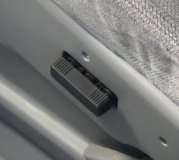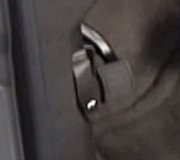First open the doors to let the fish out! Leave the battery connected to reduce the possibility of locking up some computers. This is more of a problem on Volkswagen, BMW, and GM vehicles, but we don't want to take any chances. If something electrical is going to be damaged by leaving the battery connected, it has happened already.
Look at how high the water reached on the engine and transmission. The dipsticks and fill cap should seal out any water, otherwise you'd have problems after driving in the rain. Since the car is already drowned, use a garden hose to wash everything you can. Salt water is going to be everywhere and will corrode any exposed electrical wires and terminals, and it will cause rust in the creases and folds of the body's rolled-up sheet metal. Run water everywhere possible inside and under the car, and under the hood. Living in Wisconsin, the road salt capital of the world, we know what salt does to a car but that salt doesn't get inside. Cars actually rust out worse here when they go through car washes regularly during the winter. That water pushes salt into places it normally wouldn't get to, then it sits there and won't wash out when driving in the rain later. My '88 Grand Caravan has never been through a car wash in its life and it has just started to get rusty last year. Most ten-year-old cars have more rust than mine.
Don't try to turn anything on yet. Before we had all these computers, if salt water affected something, it just didn't work right until it was dried or washed out. Today we have many dozens of computers to do things we never needed computers for before. They also provide the toys and gimmicks people demand but the price we pay is their susceptance(?) To outside factors like voltage spikes, corroded connector pins, and salt.
Run a lot of water on the seat cushions, carpeting, and inside the doors. You'll usually see a white film on dry parts when salt is still there. You can pull the rubber strip away from the door glass to get the water in, and temporarily plug the drain holes on the bottom so the water will build up high enough to dissolve the salt and wash it away. Open the drains to let the bad stuff run out, then do that a few more times.
All electrical connectors under the hood use "weatherpack" connectors that have rubber seals where the wires go in. Those terminals should be okay but days after the car is running, consider unplugging them and washing them with electrical contact cleaner, then allowing them to dry a few minutes. To avoid setting diagnostic fault codes or causing other problems, never turn on the ignition switch while any connector is disconnected. It won't hurt to run some water through the generator too, ("alternator" in Chrysler terminology). Also rinse the radiator and the air conditioning condenser in front of it. And the radiator fan motor. And the starter motor. All of those things can be expected to get wet in normal driving conditions but we don't want salt in them.
Run water on both sides of the trunk. There will be rubber plugs under the trim mat that can be pulled out to let the water run out. Even if the trunk seal held, there are drain holes right behind both rear wheels, and water will have entered through them.
If the battery is good it should last at least two weeks to keep the many computer memory circuits alive. After that you may need to connect a small trickle charger to keep it charged up. By that time it should be dry enough that a strong battery won't cause other damage. If the battery is already dead, just leave it sit for now. Charging it up at this point can only possibly cause problems, but for sure it won't solve anything that won't be solved by waiting another few days or weeks.
Very sorry to see what you guys went through but I find it interesting how differently everyone is reacting compared to after Katrina. We haven't seen many news stories showing people whining and sniveling that the government didn't do enough to babysit them. What we're seeing is people picking up and getting busy. Most of us here have the same attitude. Kudos to you.
Friday, November 2nd, 2012 AT 12:23 AM


